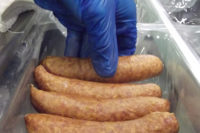Ensuring food safety in cook/chill processes


|
To produce safe RTE meat products, processors need to understand how to determine the sufficiency of cooking (lethality), chilling after cooking (stabilization), and post-lethality pasteurization of these products. Regulatory changes have shifted the burden to meat processors to ensure, through scientific justification, that existing, as well as new, processes meet lethality and stabilization performance standards. In particular, the USDA Food Safety Inspection Service’s (FSIS) RTE Final Rule in 2003, inspected meat processors must select an “alternative” approach to producing safe RTE products, and the more desirable alternatives require greater technical expertise on the part of the processors. The most important processes in producing safe RTE meat products may be cleaning and sanitizing equipment and facilities.
To fully understand what is involved in producing safe RTE meat products, employees need a combination of engineering, microbiology and chemistry principles to understand heat transfer, stabilization and sanitation. Whereas the majority of people working in the meat industry have taken meat- or food-science courses, along with HACCP training, microbiological concepts are much more commonly presented in those programs than engineering and chemistry.
Understanding how these three disciplines interconnect is most important to developing programs for producing safe RTE products. For example, one may understand the concepts of lag phase, logarithmic growth and lethality of Listeria monocytogenes from a college microbiology course or industry workshop.
However, heat transfer basics are not typically a topic of discussion in those programs. The mechanisms of heat and mass transfer explain the differences between steady-state and unsteady-state transfer. Knowing whether convection or conduction is more important to your cooking process will help you understand what is happening in your oven, as well as how to improve the cooking process.
Understanding heat transfer coefficients, thermal conductivity, heat capacity, thermal diffusivity and density of meat products is important in being able to produce safe RTE meat products, particularly as changes are made to existing products, in terms of composition (moisture vs. fat content), density, size and shape, and as new products are developed.
Understanding the effects of oven relative humidity on cooking rate, and uniformity of product temperatures is important, in addition to the impact of humidity on lethality of pathogens, such as Salmonella.
Validation of batch and continuous oven operations is very important to producing products of consistent final internal temperatures, and proof that final internal temperatures were taken in the coldest spot in the oven is a regulatory requirement. Understanding the effects of product loading, air (water or oil) movement and speed, cooking times, cooking temperatures, as well as the proper placement and operation of the wet bulb probe are keys to consistency of final internal product temperatures.
Balancing an oven is critical to producing safe meat products and is dependent upon airflow and air handling. Methods for balancing ovens and preventive maintenance checks are important.
Equipment validation issues include: frequency of validation, location and number of thermocouples used, temperature measurement equipment, and time limits for taking product temperature when done manually.
Pathogen growth and lethality modeling programs can be very helpful in supporting HACCP decisions made related to deviations and/or process changes. Understanding which model is most relevant to the process in question is one thing, but equally important is how to interpret the results generated from such modeling programs and lethality equations. Both the selection of the appropriate model and interpreting the results requires an understanding of basic microbiological principles.
Proper sanitation of equipment and facilities may be the most important means of preventing, reducing and/or eliminating Listeria monocytogenes. To me, a good sanitation program makes more sense than a critical control point (CCP) in controlling and preventing L. monocytogenes.
A good sanitation program requires a little engineering background to design facilities and equipment to be cleanable to a microbiological level. The main principles of sanitary design are providingzones of control, keeping the space cold and dry, and arranging equipment for ease of cleaning and sanitizing.
Equally important to facility and equipment design is the chemistry of cleaning and sanitizing. The appropriate cleaners and sanitizers must be selected for the job, and proper concentrations and application procedures must be followed. Even the temperature of the water used to produce sanitizers of the proper concentration is important for some sanitizers.
Some companies have gone to hiring sanitation engineers to manage this important process. However, a food scientist can also manage this with the proper training.
| INFORMATION BOX |
|
The Ohio State University Meat Science’s annual “Thermal Processing of Ready-to-Eat Meat Products Short Course” is scheduled for April 17-19, 2012. Attendees can learn about a good mixture of the disciplines mentioned in this story from speakers throughout the industry. For more information, please contact Lynn Knipe at knipe.1@osu.edu. |
Looking for a reprint of this article?
From high-res PDFs to custom plaques, order your copy today!










